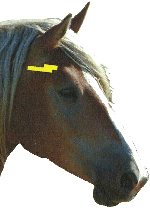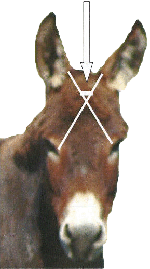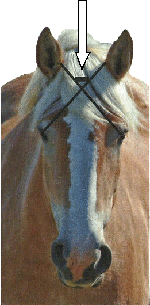Guidelines for Stunning Techniques of Mammalian Food Animals
5. Horses
5.1 Mechanical
Important factors:
5.1.1 Handling and Restraint
- Horses vary a great deal in size.
- Handling and restraint facilities must promote good animal welfare standards at all times.
- Restraint facilities must be adaptable and appropriate to the size variation of the animals slaughtered.
- The restraint facilities must be suitable for the operator to stun the animal in an effective manner.
5.1.2 Landmark and approaches
- Just above the intersection (1 in) of imaginary diagonal lines from the attachment of each ear to the medial canthus (middle corner) of the opposite eye. (See [b] and [c] below.)
- Plan the trajectory so that the bolt travels through the brain (cerebral hemispheres, midbrain, brainstem). The most significant of these are the midbrain and brainstem which are at the level of the bottom of the attachment of the ears. (See [a] below.)
- Hold and discharge the stunning device perpendicular to the front of the skull.
- The frontal bone over the brain is quite thin.



| Image | Description |
|---|---|
 |
diagonal lines running from the inner corner of each eye to the upper edge of the attachment of the opposite ear |
 |
diagonal lines running from the inner corner of each eye to the upper edge of the attachment of the opposite ear |
 |
entry point of the projectile which is approximately one inch above the intersection of the diagonal lines |
 |
entry point of the projectile which is approximately one inch above the intersection of the diagonal lines |
 |
arrow indicating entry point into the skull and brain cavity |
 |
location of the brainstem and midbrain - in the middle of the skull |
5.1.3 Mechanical Stunning Devices
5.1.3.1 Captive bolt
- Horses are very effectively stunned with captive bolt devices (e.g. Australia).
- Bolt length 12 cm (4 ¾ in) can be used to stun all horses effectively.
- Various types and triggering devices are available.
- Use the manufacturer's recommended charge, cleaning, maintenance and stunning protocols.
- Assess bolt velocity by using manufacturer's bolt velocity testing device, or similar means daily.
| Animal | Calibre | Bolt Lengths | Muzzle Velocity (ft/s) | Energy (ft/lb) |
|---|---|---|---|---|
| All horses | .22, .25, .33 | 12 cm (4 ¾ in) | 55 m/s (183 ft/s) | Appropriate charge |
5.1.3.2 Firearms
- When a proper restraint system is used firearms are not necessary to effectively stun horses.
- Firearm use is discouraged.
- Perforation and ricochet are a safety concern; therefore use the slowest velocity and minimum energy (muzzle) required to effectively stun the animal. (See below.)
| Animal | Calibre | Grain | Muzzle Velocity (ft/s) | Energy (ft/lb) |
|---|---|---|---|---|
| All horses | .22 S Table Note * | 29 | 1095 | 77 |
| All horses | .22 LR Table Note * | 40 | 1255 | 140 |
Table Notes
- Table Note *
-
Do not use hollow point.
- Date modified: